This is an Ihagee Night Exakta B, a single lens reflex camera made by Ihagee Kamerawerk Dresden starting in 1934. The very first Exakta cameras shot 6.5cm x 4cm images on 127 “Vest Pocket” format roll film, sharing a similar shape body to the later 35mm “Kine” Exaktas that followed it. This camera is the “Night Exakta” variant which came with faster lenses that required a larger focusing grip to be used on the lens mount. The Night Exaktas have the same lens mount as non-Night Exaktas and can accept the same lenses, they’re just harder to focus with the smaller grip. The rest of the camera is the same as the regular Exakta B, including a focal plane shutter with speeds from 12 seconds to 1/1000, a fixed waist level reflex viewfinder, self-timer, and rapid film advance lever.
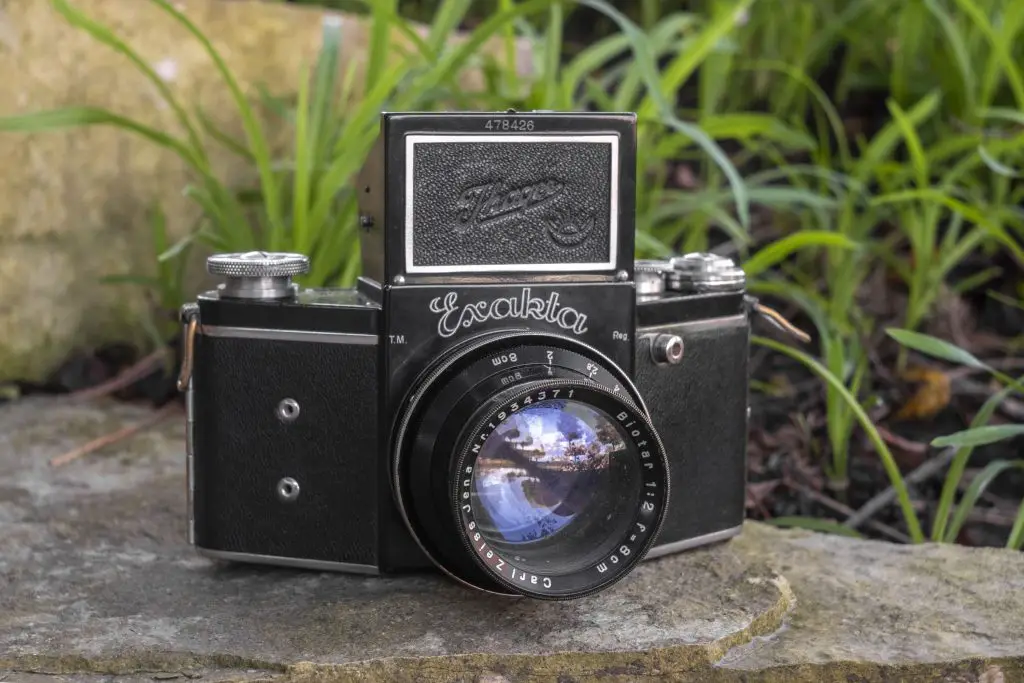 Film Type: 127 Roll Film (eight 6.5cm x 4cm exposures per roll)
Film Type: 127 Roll Film (eight 6.5cm x 4cm exposures per roll)
Lens: 8cm f/2 Carl Zeiss Jena Biotar uncoated 6-elements in 4-groups
Lens Mount: Exakta 39.8mm Screw
Focus: 3.5 feet to Infinity
Viewfinder: Waist Level Reflex Viewfinder
Shutter: Cloth Focal Plane
Speeds: Z, B, 12 – 1/1000 seconds
Exposure Meter: None
Battery: None
Flash Mount: Vacublitz Flash Socket, 1/25 Flash Sync
Other Features: Self Timer, Magnifying Glass, Sports Finder
Weight: 1085 grams (w/ lens), 729 grams (body only)
Manual: https://www.cameramanuals.org/exakta/exakta_a_b_junior.pdf
How these ratings work |
The original Ihagee Exaktas are some of the most historically significant cameras ever made. Opening the door for miniature SLRs that would eventually lead to the 35mm Kine Exakta, Asahiflex, and Nikon F, these cameras were incredibly well built, had a large array of features for their time, and a selection of amazing lenses. The Night Exakta reviewed here is gorgeous and a lot of fun to operate. As with most Exakta’s it’s operation is slow, and the ergonomics are not what we’re used to today, but once you get over that, these are incredible cameras to shoot. If only 127 film was easier to come by today. | ||||||
| Images | Handling | Features | Viewfinder | Feel & Beauty | History | Age | |
| 2 | 1 | 2 | 2 | 2 | 2 | 40% | |
| Bonus | none | ||||||
| Final Score | 15.4 | ||||||
The Ihagee Exakta is one of the longest lived camera brands of the 20th century. The original roll film Exakta led the way to the 35mm “Kine” Exaktas which would quickly become the dominant miniature format Single Lens Reflex in the world, a title it would hold for nearly two decades before finally being superseded by more advanced designs from Germany and Japan. With a production run from 1933 to 1988, the number of Exakta cameras is vast and far beyond the scope of this article.
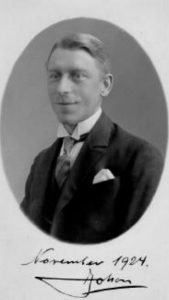
Ihagee was founded by a Dutchman named Johan Steenbergen as Industrie-und Handelsgesellschaft which stands for Industry and Trade Society. Often referred to by the nickname IHG, the company name was eventually shortened to Ihagee Kamerawerk since Ihagee is pronounced the same in German as saying “I H G”.
Steenbergen was born in the northeast city of Meppel, Netherlands on December 7, 1886. His parents, Jan and Sophie were in the drapery industry, owning two shops which were said to be two of the most highly regarded in the country. In his younger years, Johan Steenbergen worked in the family store, but around the time he graduated high school, he realized that perhaps the family business wasn’t for him.
Jan Steenbergen died unexpectedly when Johan was only 18 years old, and for the next three years would continue to work in his father’s store, Steenbergen started a side business selling photographic equipment, chemicals, and gramophones.
In 1908, at the age of 21, at the recommendation of his uncle, Steenbergen decided to focus entirely on his love for photography and moved to Dresden, Germany. There, he started an apprenticeship with Heinrich Ernemann, AC Dresden, where he worked as a mechanic. In 1910, Steenbergen was listed on a patent for Ernemann, suggesting he quickly advanced to the company in some sort of design or engineering position.
In April 1912, Steenbergen, with financial backing from the bank of Dresden, formed Industrie-und Handelsgesellschaft m.b.H. Kamerafabrik mit Kraftbetrieb as a wholesale trader of photographic products (equipment, accessories and chemicals) and the production of equipment. At this time, there were already a large number of Dresden based photographic businesses, so Ihagee’s original purpose was likely to supply those companies using parts built by someone else. Within a few years after it’s creation, Ihagee’s focus narrowed to construction of new equipment and the company’s name was shortened to Ihagee Kamerawerk
GmbH.
Little is known about the exact identities of Ihagee’s products as many were sold as “white label” designs for other manufacturers or distributors. There were some branded cameras sold under the names Photorex and Coronoa, but a large number of early Ihagee cameras were not labeled with a name, making identifying early Ihagee cameras very difficult.
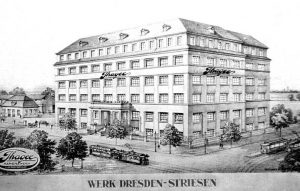
Between 1919 and 1923, Ihagee’s business grew and moved locations a number of times, and in 1923, the company’s location was in the Dresdener district of Striesen, near factories for Ernemann and Ica.
Despite moderate success in this era, by the start of the 1930s, Ihagee was still a couple of years away from the company’s greatest accomplishment, the Exakta camera. It is not clear when work began on the Exakta, but interest in a miniature format single lens reflex may have begun around 1925 with the release of the Leica which used double perforated 35mm film.
The Leica was produced in Wetzlar, and despite still being a German company, might as well have been a world away. What was going on in Wetzlar had little effect on Dresden, at least not until 1932 when Zeiss-Ikon released the Contax.
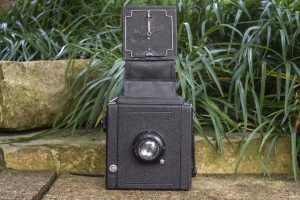
Ihagee’s experience making large format reflex cameras like the Ihagee Paff-Reflex and Serien-Reflex, likely motivated them to produce a miniature reflex camera. Instead of using double perforated 35mm film like Leitz and Zeiss-Ikon used, Ihagee’s new camera would produce larger 40mm x 65mm images on 127 roll film. The term “miniature” when applied to film in this era included all types of small film, including 35mm and 127.
Note: Despite scouring through as much English, Dutch, and German language histories on Ihagee and Dresden, I could not find any mention of who actually built the first Exakta, when it started, or anything about it’s early development. The most common name that comes up as the designer of the Exakta is Karl Nüchterlein, but as best as I can tell, his role was in developing the 35mm Kine Exakta in 1936. Whether he was involved in the original is unclear.
Whoever and however the Exakta came to be, the earliest cameras rolled off Ihagee’s assembly lines in late 1932 and the camera would make it’s debut at the 1933 Spring Fair in Leipzig, Germany. The name Exakta is thought to refer to being able to see exactly what will be captured on film through the camera’s lens.
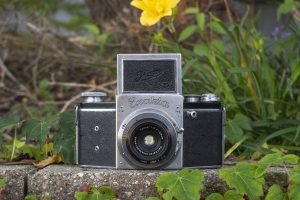
The first Exaktas were basic models, known today by collectors as the Exakta A. These early cameras are easy to identify as they lack the delayed action knob on the right side of the top plate that controls the self-timer and slow shutter speeds. Only the fast shutter speed dial with speeds from 1/25 to 1/1000 were available. The earliest Exakta As also lacked the film advance lever and used a knob.
Several months after the release of the original Exakta, a more advanced model called the Exakta B was released alongside the now rebranded Exakta A, which added the delayed action knob allowing for up to a 12 second exposure and a self-timer function. The Exakta B was available in both black painted and chrome plated versions. Exakta Bs are probably the most commonly found today.
The Exakta was warmly received as it’s compact size and larger than Leica images meant that it could produce exposures with excellent quality. With it’s interchangeable lens mount, and a long list of accessories made for it, the Exakta was the first compact single lens reflex system camera.
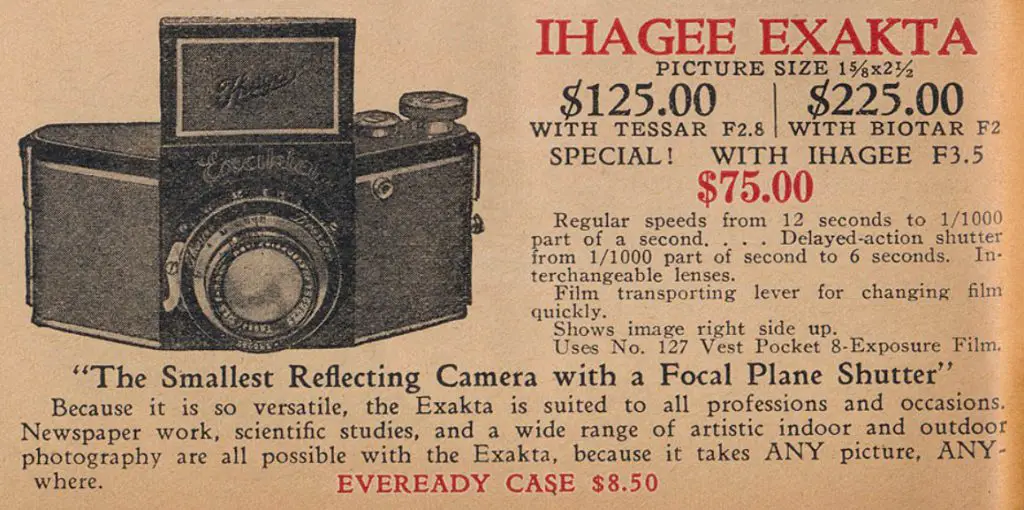
When it was exported to the United States the camera could be purchased for as little as $75 with an unnamed Ihagee f/3.5 lens, or as much as $225 with a Carl Zeiss Biotar f/2 lens. When adjusted for inflation, these prices compare from $1500 to $4500 making acquiring one an option only for the extremely wealthy.
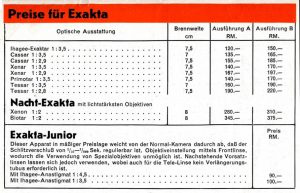
Alongside the Exakta A and B, in late 1934, an Exakta B variant nicknamed the Nacht, or “Night” Exakta was released which added support for a series of larger and faster lenses, such as the Carl Zeiss Biotar 8cm f/2 lens. The name “Nacht-Exakta” does appear in some German and English language advertisements of the era, but is not printed anywhere on the camera itself, which leads to some confusion as to which cameras are Night and non-Night Exaktas.
Note: I found some references online where people suggested that if an early Exakta was black, then it was a Night Exakta and this is not true. The term “Night” refers to faster lenses that were included with those cameras, and a larger focusing mount which made those larger lenses easier to use.
Both Night and non-Night Exaktas were available both in chrome and black bodies. Just because you see a black body, does not automatically make it a Night Exakta.
The most obvious difference between a Night Exakta B and a regular Exakta B is that the Night Exakta has a much larger focusing wheel behind the lens mount. This is to accommodate the much larger lenses that if installed on a regular Exakta B would completely block the focus wheel. Although several sub variants of the Night Exakta exist, most of them have the body serial number on the back edge of the viewfinder hood, whereas regular Exaktas have it on the focus ring.
Note 2: Another misconception found online about the Night Exakta on websites like camera-wiki.org is that the lens mount on Night Exakta lenses is physically larger than the original Exakta and that lenses between the two cannot be interchanged, which isn’t completely true.
The diameter and pitch of the screw mount threads are the same between the two types, and the lenses can be interchanged, however there will be a difference in where each lens focuses to infinity. Mounting a Carl Zeiss Tessar 2.8 lens from a regular Exakta B onto a Night Exakta will work, but you will not be able to rely on the focus scale to be accurate. You will however, be able to precisely focus the lens using the viewfinder.
The opposite is true too, as you can mount a Night Exakta lens on the regular Exakta, however once again the focus scale will be off, and the smaller focus ring on the body will be hard to use.
The following English language flier is dated January 1, 1939 and on the last page says it is from a Bell & Howell distributor. It shows how the Vest Pocket Exaktas were marketed back then, along with prices for the camera and it’s various lenses and accessories.
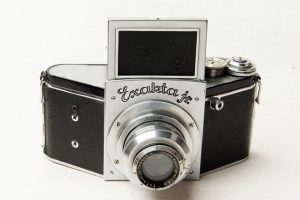
Other variants of the Exaktas existed too, such as the Exakta Jr. which was a lower cost model than the Exakta A limiting it’s top speed to 1/500 and losing the delayed action knob. There was a name variant of the Exakta Jr. called the Ihagee Jr. which was not sold as an Exakta at all, and finally a model called the Exakta C which had a removable back for use with sheet film.
Over the course of it’s production, a large number of variants with subtle changes were produced, sometimes moving the lens release pin to opposite sides of the camera, changes to flash sync ports, and others with several minor cosmetic changes.
There do not appear to be any accurate numbers of how many were made, but the number was much smaller than the later 35mm Exaktas, making finding these cameras a bit more difficult today, especially in working order.
The Vest Pocket Exaktas ended production around 1939 and did not continue after the war, as by that time, the 35mm “Kine” Exaktas were already selling strong, and a general preference for 35mm film over 127 meant that there wouldn’t have been much of a market for an advanced 127 SLR.
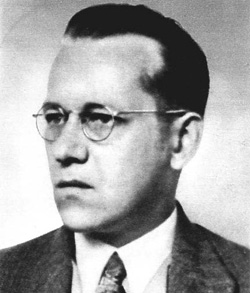
The Kine Exakta was the world’s first 35mm SLR to enter production when it was released in 1936. The word “Kine” was never an official name given to the camera, but was commonly used to differentiate it from the 127 Vest Pocket Exaktas as the word “kine” refers to the double perforated 35mm film which then was considered cinema, or “kine” film. It was designed by Karl Nüchterlein, who retained the general shape and left handed controls of the original, and created an all new camera. Despite having some similar design characteristics, 127 and 35mm Exaktas are very different cameras.
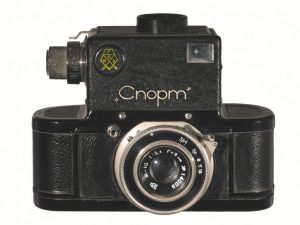
Over the years, there has been much debate as to whether or not the Kine Exakta was truly the first 35mm SLR, as a Soviet camera built in Leningrad, Soviet Union by GOMZ called the Sport (Cyrillic: Спорm) is said to have been created in 1934. Further research proves that while a prototype of the Sport did exist in 1934, it only existed in prototype form, and the camera was not completed and offered for sale until 1937, meaning the Kine Exakta was the world’s first 35mm SLR that was both finished and offered for sale.
As early as 1939, Johan Steenbergen anticipated the possibility of losing control over his company to Germany’s Nazi government and took steps to isolate himself from a future takeover. That year he gave his accountant and friend Dr. Erich Glier power of attorney to act on his behalf in the event of his absence. In 1941, after a short imprisonment by the German government, Steenbergen split his company into two, separating the trademarks and business side from the rotating capital. A new company called Steenbergen & Company would own the land, buildings and machinery in an attempt to at least retain some ownership of his company after the war.
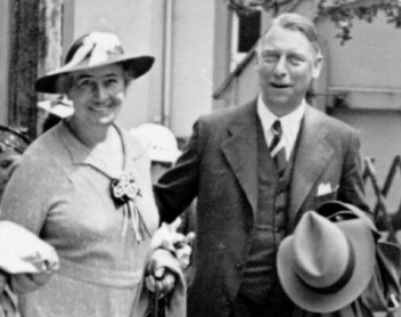
After it was becoming clear that staying in Germany was no longer safe, Johan and his American born wife Elisabeth fled Germany in 1942, first stopping in Lisbon, then New York, and finally settling in San Francisco where his wife had family. While in San Francisco, Johan Steenbergen attempted to represent the interests of his company, establishing relationships with other optics companies in an attempt to resume production of Exakta cameras under a new owner. Despite his best efforts, his attempt to restart Ihagee in America failed, and in late 1943, he took on a role in the Dutch consulate in San Francisco eventually being appointed as honorary consul.
After the war, because of his role as director of a large German industrial company, the Dutch government asked him to go to West Germany as a member of the occupying powers. There he was promoted to a Colonel in the Dutch military and served as an ambassador to the Dutch government with Allied countries.
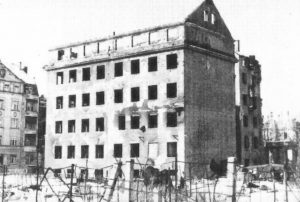
In addition to his diplomatic responsibilities, Steenbergen hoped to return to Dresden to help rebuild his company. He had received word from Ihagee employees who remained in Dresden that although the factory was completely destroyed, many of the machinery and equipment had been rescued and relocated to a different facility. Unfortunately, the Soviet government denied Steenbergern’s request to return to Dresden and he was forced to stay in West Germany.
Now under Soviet control, what was left of Ihagee’s Dresden factory was rebuilt, and the prewar Kine Exaktas resumed production. A model with slightly different cosmetics called the Exakta II would be released in 1949, and an all new model with interchangeable viewfinders called the Exakta Varex would come in 1950.
Johan Steenbergen’s clever restructuring of Ihagee’s assets and his status as a high ranking diplomat meant that the Soviet controlled East German government treated Ihagee different from other Dresden area camera makers. Not wanting to damage foreign trade relations, the operations and distribution of the company remained largely unchanged in the years following the war.
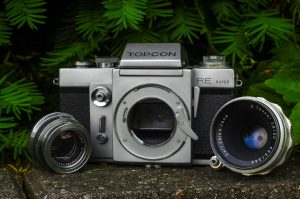
Ihagee continued business as Ihagee Kamerwerke AG Dresden and continued to evolve the Exakta into the world’s most popular and successful 35mm system camera. A huge number of viewfinders, lenses, and other attachments were made for the camera. The Exakta was so popular, that it’s lens mount was used on a few other Japanese SLRs in an effort to maintain compatibility with the huge number of Exakta lenses that existed.
The Exakta would be the professional 35mm SLR camera of choice through the end of the 1950s, until several Japanese cameras, most notably the Nikon F quickly took over the top spot.
Despite being nearly three decades old by this point, the Exakta stayed in production throughout the 1960s, with several changes made to the original formula, eventually being discontinued in 1972. A number of other cameras bearing the Exakta name were produced, some like the West German produced Exakta Real, and Pentacon produced Exakta RTL 1000 were made, but shared little in common with the original camera.
Today, Ihagee Exaktas are some of the most commonly collected cameras made as there is a lot to like about them. With a huge number of them made over the course of four decades, there are a huge number of them out there, when found in good working condition, are still capable of excellent quality photos, and even sitting on a shelf, are some of the most attractive cameras ever made.
The earlier Vest Pocket Exaktas are much harder to find, but highly sought after by collectors due to their great looks and historical significance. It is highly likely that anyone wanting to get into collecting old Exaktas will probably start off with one of the 35mm models, don’t count out the 127 models as they are quite nice cameras too and worthy of putting on your shelf.
My Thoughts
In 1995, the Eastman Kodak Company discontinued production of 127 film, ending nearly a century of support for a film format that hadn’t seen any new cameras released in decades, and of the ones that were, none of any substantial quality in over half a century. 127 film cameras were a bit of an oddity in the mid to late 20th century as they offered larger exposures than 35mm in bodies that were sometimes smaller than their double perforated counter parts.
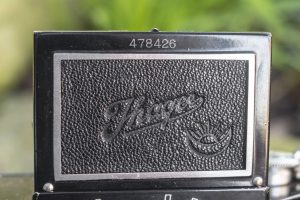
I’ve reviewed a number of 127 cameras on this site before, but if they were made after World War II, they were likely inexpensive plastic cameras with simple lenses and limited control over exposure. With the exception of 4×4 TLRs like the Yashica 44, if you want to shoot 127 film on a premium camera, you had to look for something very old.
With this review of this Ihagee Night Exakta B, I can say that I’ve now shot with one of the truly great 127 cameras ever made. This camera came from my friend and collector Kurt Ingham with a second Vest Pocket Exakta that had issues with it’s shutter, and a bunch of lenses. Between the two, the Night Exakta had the better shutter, and with 127 film at a premium, I devoted my limited film supply to that one camera, but almost everything I can say about the two is the same. Any differences will be noted.
Note: In an effort to save myself from repeatedly describing the cameras as “127”, “Vest Pocket” or “Night” Exaktas, unless I am specifically referring to one model over the other, I will refer to both 127 Exaktas as the VP Exakta for the remainder of this review, even though that’s not the technically correct name.
Upon pulling the VP Exaktas out of the package, I was immediately impressed with it’s size. Both the black Night Exakta and chrome Vest Pocket Exakta appeared to be much heavier and larger than I remember my 35mm Exaktas to be. Strangely, when I placed one of the cameras on a shelf next to a 35mm Exakta, the differences in size seemed to be much less than I had thought.
In the gallery above, I show the chrome VP Exakta next to an early post-war Kine Exacta and the overall width and height of the two bodies aren’t that much different. The VP Exakta is only 1-2mm wider, and nearly identical in height. With the waist level finders up, the Kine Exacta is actually a tad taller. On a scale, the weight of the two bodies aren’t that much different with the Kine Exacta body seen in the images above only 42 grams less at 687 grams. The two dimensions where the VP Exakta is different is front to back, as the side profile shows a much thicker camera due to the larger mirror box required by the larger 65mm x 40mm exposure size, and also when mounted with the massive 8cm f/2 Zeiss Biotar lens.

From the top, it is clear that Ihagee retained much of the earlier Exakta’s control layout when they released the early 35mm “Kine” Exaktas. For anyone whose never handled an Exakta of any kind, it probably comes as a surprise that many of the camera’s controls are used with the photographer’s left hand. The film advance lever is on the left, next to the two piece shutter speed dial which features fast speeds from 1/25 to 1/1000 plus Bulb and Z (Timed).
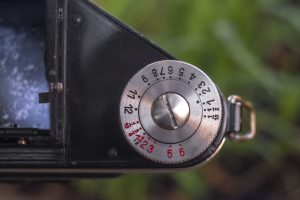
Like later Exaktas, the VP Exakta uses the delayed action knob to the right of the viewfinder as both the self-timer and slow speed governor for shutter speeds 1/10 down to a full 12 seconds. Whether you are using the self-timer, a slow shutter speed, or a combination of the two, this knob must always be wound as far as it will go. Also, you must always cock the shutter first before turning this knob as it will not hold it’s position if the shutter is not ready.
As you turn the knob, it’s resistance will increase, but it is important that you always turn it until you feel a firm stop, indicating it has reached it’s limit. Failure to turn this knob all the way can cause the mechanism to not work correctly. The amount you have to turn this knob depends on how it was used previously.
Note: Each of the following three situations assume the shutter is already cocked and the delayed action knob is already rotated as far as it will go.
To use the self-timer with a fast speed, select any speed on the fast speed dial from 1/25 to 1/1000 and then lift and rotate the outer part of the delayed action knob until one of the red numbers lines up with the black dot in the center of the knob and then let it drop back down into position. When firing the shutter, the shutter will fire at whatever fast speed you have selected after an approximate 12 second delay. It does not matter whcih red number you select, for the self timer, the delay will always be about 12 seconds.
To use slow shutter speeds from 1/10 to 12 seconds, you must first set the fast shutter speed dial to either B or Z, then repeat the previous step, except instead of choosing one of the red numbers, you choose one of the black numbers from 1/10 to 12. When firing the shutter, the first curtain will immediately open and remain open for the duration of whatever slow speed you’ve chosen.
To combine both a slow shutter speed with the self-timer, repeat the previous step, except instead of choosing one of the black numbers, choose a red number from 1/10 to 6 seconds. When firing the shutter, an approximate 12 second delay will precede the shutter opening for the duration of whatever red speed you’ve chosen.
This unique implementation of both slow shutter speeds and the self timer would continue with the Kine Exakta models all the way through the VX1000 series in the 1960s. When Pentacon would produce the Exakta RTL1000 in 1969, it would feature a modified implementation of this in which the self timer lever also functions as a slow speed governor.
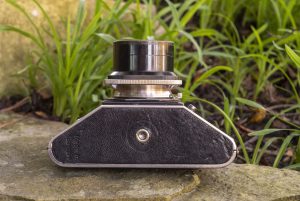
Flip the camera over, and the bottom has a centrally located 3/8″ tripod socket and nothing else. In the 1930s when this camera was made, the 1/4″ tripod standard had not been adopted yet, so it is not unusual to see a camera from this era with this size socket. If you wanted to use the VP Exakta on a modern tripod, you’d need an adapter.
If you look carefully, embossed into the leather are the words “Made in Germany”, possibly suggesting this particular camera was built for export.
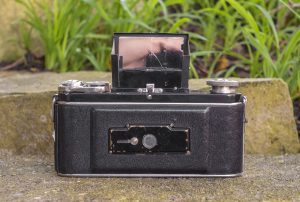
Around back, the VP Exakta looks more different than from any other angle. The most obvious difference is in the sliding door for the exposure counter peep hole. Like most 127 film cameras, the VP Exakta relies on the printed numbers on the film’s backing paper as it lacks a proper exposure counter like 35mm Exaktas have. When advancing the film, you must slide open the metal door to look through the window and stop at each exposure number.
The VP Exaktas have a rudimentary double exposure prevention, which prevents you from firing the shutter until it has been completely wound, but it lacks any sort of stop at the beginning of each new exposure, so you must pay attention to these numbers and not overwind, or else you’ll waste film.
Another oddity of the VP Exakta is that the film advance lever completes the shutter setting cycle far before you’ve reached the beginning of the next exposure, so you must continue advancing the film, even after feeling that the shutter has been fully set, before the next exposure number will show up. The force required to continue advancing the film is much different after the shutter is set, but before reaching the next exposure. The first time I used the VP Exaktas, I had to check the user’s manual to confirm I was doing it correctly.
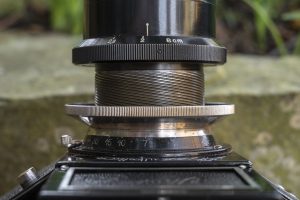
The VP Exakta has the focusing helix built into the lens mount, similar to that of the Zeiss-Ikon Contax. This means that by using the same helix for every lens attached, the lenses can be smaller as they can be made without one.
Unlike the Contax however, the helix is exposed on the Exakta which looks a little strange if you’ve never seen one before. In fact, the first time I saw a VP Exakta, I assumed something was missing as it looked strange to see this part of the camera out an open.
As a result, special care must be taken not to touch the threads, as you could easily transfer grease from the threads to your fingers, but even more important, is that if you get any debris on the threads, this could cause the focus action to feel gritty, or worse, damage them. As a precaution, when not using the VP Exakta, the lens should be focused beyond infinity, retracting the lens into the body and covering up the exposed helix.
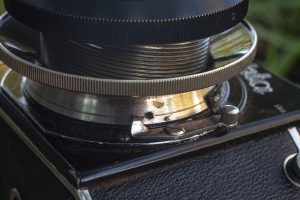
Another interesting feature of the VP Exakta’s mount is an indexing hole that is on the side of the focus helix. This hole serves two purposes, the first is as an infinity lock, preventing the distance from changing when set to infinity, but the hole also serves as the point to which the lens has been extended out enough so that the shutter may function.
As mentioned earlier, the VP Exakta can focus beyond infinity, which retracts the focusing helix into the body, protecting it. When the lens is retracted, the shutter release will not function, and depending on which lens is attached, the reflex mirror may also become blocked.
A swiveling arm, which looks quite a lot like the lens release on all 35mm Exaktas, must be pressed to allow the focus helix to rotate beyond this indexing hole. In the previous image to the left, I intentionally left the hole exposed, so you can see it. This particular VP Exakta I have for this review has this swiveling arm on the camera’s left side. There were several different variants of the VP Exaktas, some of which relocate this to the right side. Whether you have a left or right side version, it’s function is the same.
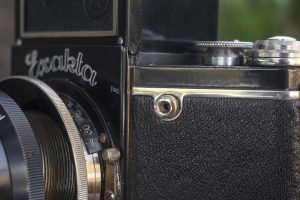
On the front face of the body, on the photographer’s left side, is the cable threaded shutter release button. This distinct location for the shutter release was carried over to the Kine Exakta and all Exakta bodies that were made after it. As mentioned above, this button will become locked if the lens is not fully extended out of the body, beyond the index hole.
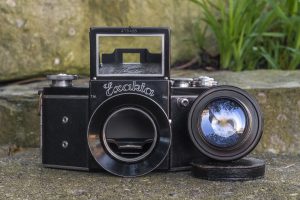
The original VP Exakta from 1933 used a smaller 39.5mm screw mount which is not compatible with later VP Exaktas like the ones reviewed here with a 39.8mm screw mount. Like other screw mount lenses, they mount by turning them clockwise until they stop, and dismount them by turning counterclockwise. Fully mounting and dismounting the lenses requires nearly four complete rotations before the lens is secure, which is almost twice as much as cameras with the 39mm Leica Thread Mount.
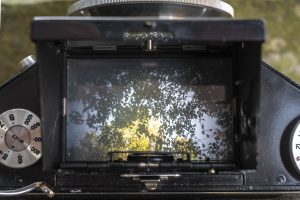
The Exakta has a fixed waist level viewfinder that under normal use, allows for through the lens composition at waist level like most other cameras with waist level finders. As with all waist level finders, the images is reversed left to right. Pressing a small release near the rear edge of the viewfinder frame, the hood should spring open revealing a large piece of ground glass for precision focus.
There are no focus aides such as a split image or microprism circle, neither of which would have been common at the time. The focusing screen is also rather dark, making indoors or low light composition difficult. Also, since the VP Exakta pre-dates lenses with automatic diaphragms, you must remember to manually open and close the lens diaphragm, if you want to let extra light into the viewfinder.
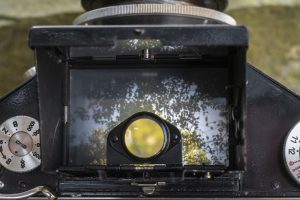
Also like most cameras with waist level finders, a small magnifying glass can be used for precision focus. To use the magnifying glass, press down on the small release near the bottom right corner of the back of the viewfinder hood, and both a secondary optical frame and the magnifying glass will pop up. Hold the camera at about chest level and look through the magnifying glass for precise focus.
Using the Exakta VP at waist level or chest level with the magnifying glass should cover most shooting situations, but Ihagee cleverly added two additional ways to shoot the camera at eye level.
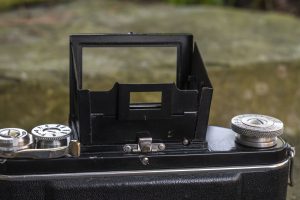
The first is for fast action shots where precise focus isn’t necessary. With the viewfinder hood up, and the magnifying glass up, a secondary optical viewfinder opens in the rear edge of the hood. Using your finger, press on the front face of the hood until the middle section of the hood folds all the way down. With the front of the viewfinder hood folded down, you can see straight through the rear optical viewfinder using the frame of the front edge of the viewfinder as a “sports finder”. By bringing your eye close enough to the rear finder, anything seen through the front frame should be in focus with the lens focused at or near infinity. When finished shooting like this, a small release on the outside of the right side of the hood can be pressed to allow the front face to return to it’s original position.
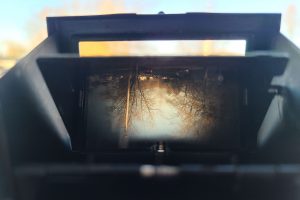
But wait, there’s more! A fourth option allows you to use a reflective mirror surface on the inside of the folding front face at a 45 degree angle which allows you to still see the focused image on the ground glass, with the camera at eye level. In this mode, the image will not only be reversed left to right, but it will also be upside down, making shooting any kind of action, very difficult.
To use this mode, the magnifying glass and rear optical finder need to be folded shut, with the front face folded half way down, at a 45 degree angle. A two position catch on the right side of the hood should hold the mirror at a perfect 45 degree angle, allowing you to hold the camera to your face, while looking into the mirror, which reflects light seen through the ground glass to your eye. The mirror will not catch at the 45 degree position if the magnifying glass is up. A small release on the outside of the right side of the hood allows you to return the mirror to it’s original position, or raise it from the previously mentioned sports finder position.
If the above descriptions are difficult to visualize, the short video below shows the camera in all four of it’s viewfinder modes.
For anyone who has ever shot a 35mm Exakta before, using any of the VP Exaktas is pretty similar. The two biggest differences are the larger size of the body and viewfinder, and having to use the exposure number peep hole on the back of the camera.
Although you only get eight exposures per roll, at 40mm x 65mm, the exposures have three times the area of a normal 24mm x 36mm exposure on 35mm film. The viewfinder is dark, but no worse than any other 1930 SLR, and although the camera is heavy and a bit awkward to hold, it’s not something a good neckstrap couldn’t help with.
I knew going into this camera that it’s shooting experience would be slow and would require some extra concentration, but I was prepared for that. Having high expectations for the VP Exakta, I couldn’t wait to put a couple rolls of film through it!
My Results
As my time with the Vest Pocket and Night Exaktas was limited, I wanted to maximize my experience with it, and I thought it was time to open up a box of new old stock Kodak Gold 200 127 film that expired in 1995. This roll of film is likely from one of the very last batches Kodak ever made of 127 film as it contained a note in the box warning consumers that it and 620 film were no longer going to be made. Knowing that despite this being a relatively “fresh” roll of original 127, it was still nearly three decades old and would need some extra exposure, so I shot it like as if it was an ASA 50 speed film.
For this first roll of film, I shot half the roll using the Biotar 80mm f/2 lens for the Night Exakta, and also the 7.5cm f/2.8 Tessar for the regular Exakta B, proving that non “Night” lenses do work on the Night Exakta. Unfortunately, for the first two images, I did not pay enough attention to the ground glass, resulting in slightly out of focus images. This was my own error, and upon paying closer attention, I was able to get properly focused images for the rest of the roll using both lenses.
I shot a second roll of expired Supre-Tone 127 that dates back to the 1960s. This is a black and white ASA 50 speed film that I have used many times and know that it still shoots well at box speed, so that’s how I used it.
A quick note about the image of the two grain towers in the gallery above. The reason part of the image is much lighter than the other is that while making this photo, my finger accidentally came in contact with the shutter speed dial which spins as the shutter fires. This is something that was common with many cameras, including early Leicas, back then, and is something you should be extra careful with when shooting a Vest Pocket Exakta.

Looking through both galleries I shot with the Vest Pocket Exakta, I can’t help but feel the images were affected by the state of the 127 film I used. The color film was nearly 30 years old, and the black and white over 60, so of course it’s going to have an impact. Although some places like Film for Classics will sell freshly cut 127 film made from other stocks, or I could just slit my own 120 down to 127, this takes time and I just felt like I wanted to use genuine film in what would likely be one of the coolest 127 cameras I’d ever get to try.
So with the degraded film stocks, I can still declare the image quality from the Vest Pocket Exakta a winner. I primarily used the 8cm f/2 Zeiss Biotar lens for these galleries and most of the images turned out a bit soft. This is likely caused both by a tiny amount of haze in the lens, plus uncoated prewar lenses just tend to have a bit of a glow to them, but it’s hardly obtrusive.
Despite not being razor sharp, I think the images all have a look that is consistent with how images shot from this camera might have looked 80 years ago when it was new. Film was much less sharp back then and color film was still in it’s infancy. Kodachrome, the first widely successful color film emulsion didn’t even exist when the first Exaktas were produced, so any color images that might have been shot back then would have had otherworldly colors like the ones I got on the heavily expired Kodak film.
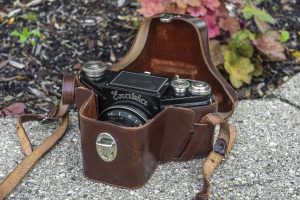
Shooting the Vest Pocket Exakta wasn’t that much different from a 35mm Exakta. The camera is a bit heavier, and it’s more angled front edges meant gripping the camera without a strap was much more difficult. While it’s a good idea to use some kind of strap on any camera, this is one you absolutely need one as the body’s trapezoid shape is not very secure. If this was a camera I thought I would use regularly, I would definitely look into some kind of 3D printed hand grip that I could attach to it for more security.
Changing shutter speeds was effortless, advancing the film does require you to keep opening the peep hole in the back door to see the exposure numbers on the backing paper, but was otherwise uneventful, and although I never used the self timer or slow speeds, these seem to work exactly as they do on later Exaktas.
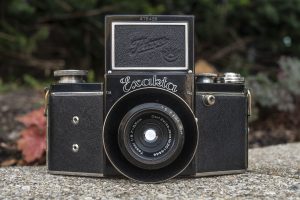
Using the large waist level viewfinder was like any other waist level SLR I used. Although the Vest Pocket Exakta has four different viewfinder modes, I never bothered to use either of the fast action “sports finders” while shooting. The viewfinder is dark, but is still very usable outdoors. You’ll notice that other than the mirror selfie, none of the other images in the galleries above were taken indoors, and that was with the bright f/2 lens attached. With a slower lens attached like the 5.5cm f/8 Zeiss Tessar in the image to the left, the viewfinder is almost completely unusable.
If you compare the Vest Pocket Exakta to an SLR from the 1950s or later, it is going to seem very strange. With it’s left handed controls, angled body, and large viewfinder, it’s not like any else out there, but compared to other 1930s SLRs, it is amazing at how much Ihagee got right with this camera. When the decision was made to create a 35mm version of this camera, they kept a lot the same and we all know how successful the Exakta turned out to be. Other than the necessary parts to use 35mm versus 127, and a bayonet lens mount, the Vest Pocket Exakta has more in common with 35mm Exaktas than it doesn’t.
This is a really neat camera that I was extremely fortunate to get a chance to use. Not only are these cameras not common, but finding one in this good of condition is really special, and I am very thankful to Kurt for loaning this one to me. Kurt has sent me a lot of very cool cameras, some worth far more than this one, but I have to say, that if he ever took me aside and said pick one from his collection to keep, I think this black Night Exakta with the f/2 Biotar lens would be my selection.
Related Posts You Might Enjoy
External Links
http://camera-wiki.org/wiki/VP_Exakta
http://web.archive.org/web/20180225150303/http://www.exakta.org/orgvp/orgvp.html
https://www.pacificrimcamera.com/pp/ihageevp.htm
https://www.dancuny.com/camera-collecting-blog/2020/12/21/vp-exakta-model-b

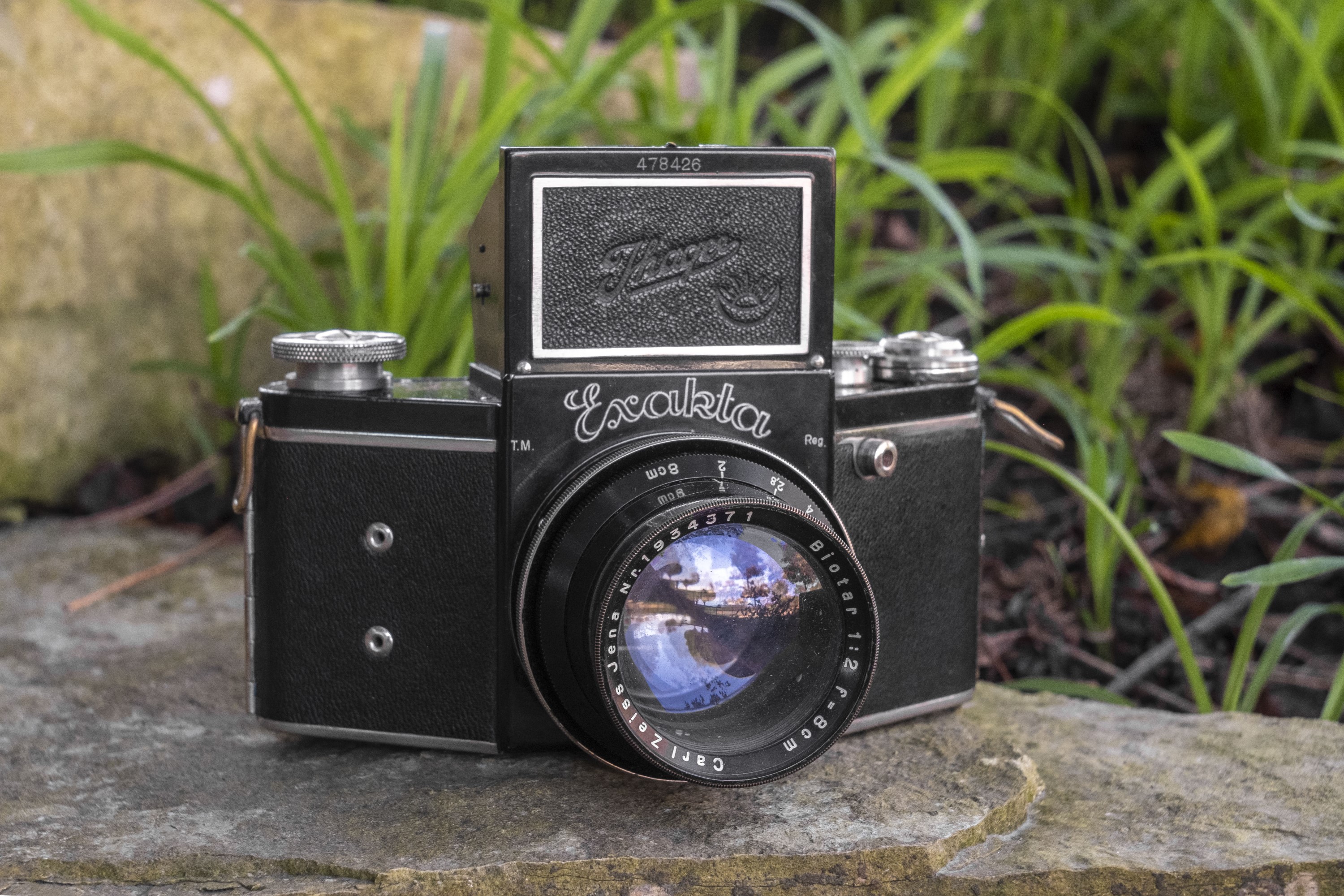

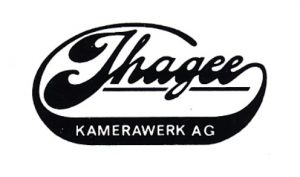
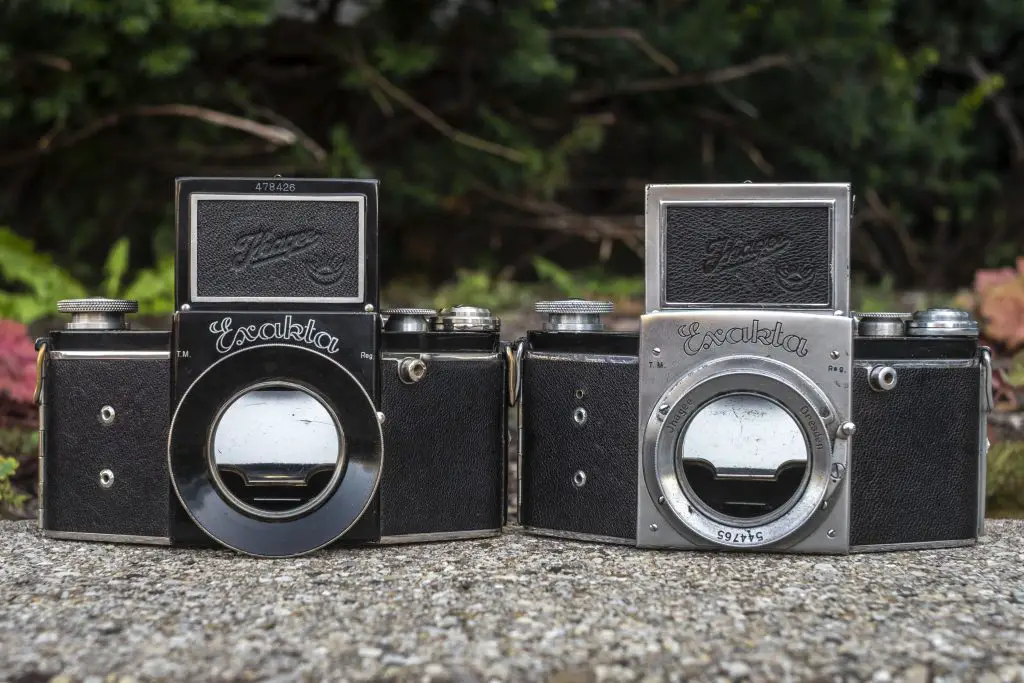
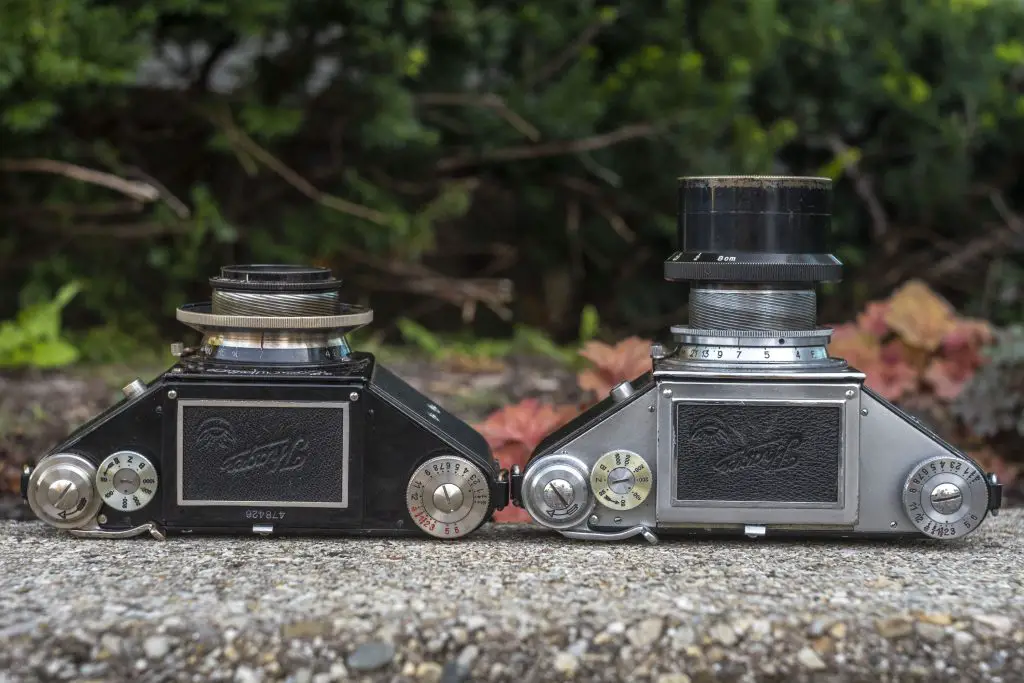
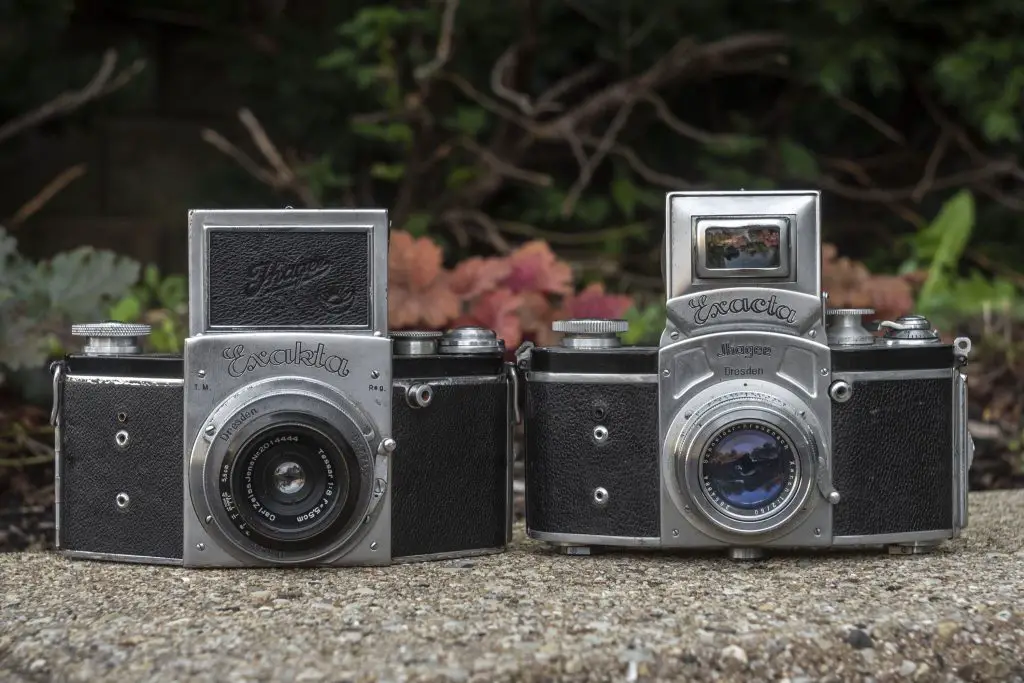

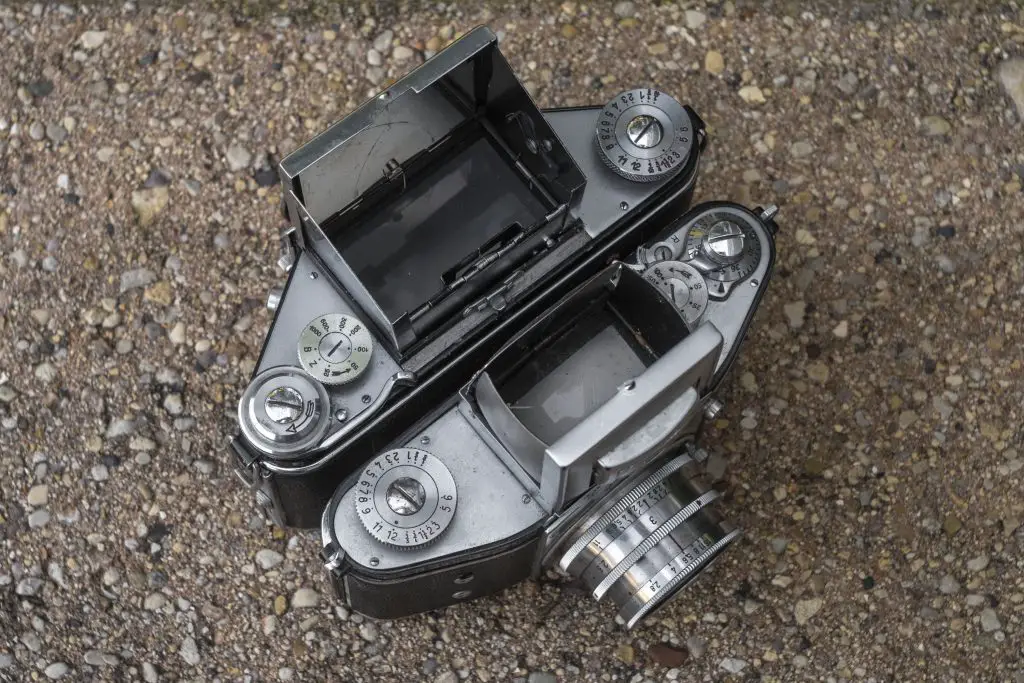
















Great review of a remarkable lens/camera combination. Thanks go to you and to Kurt.
Glad you enjoyed it Roger! I spent a lot of time on this one. Originally this was supposed to be posted on 12/7, but I had so much to put into it, I delayed it to 1/27! 🙂